
'Cultural property crimes have been linked by the United Nations and others to terrorism.'
'These links show the perpetrators to be associated with major criminal and terrorist networks like ISIS.'
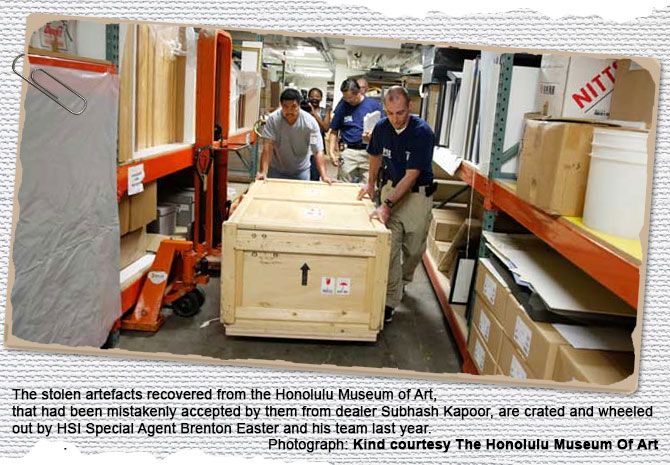
For an excited five-year-old boy, perched on the edge of his seat in a New England theatre, nothing could be more thrilling than watching the exploits of an archaeologist-professor, played by Harrison Ford, who escapes his university classroom to heroically assist North Indian villagers recover the holy Sankara stone relic belonging to their ancient temple.
The Steven Spielberg film and Indiana Jones -- its swaggering, fedora-sporting hero, who salvages historical loot -- made a lasting impression on the little boy. Especially since he was seeing Indiana Jones And The Temple of Doom for the second time!
He had already seen it on television at home and hankered to see Indiana Jones' swashbuckling antics, king size, on the big screen too. But his town lacked a cinema. The youngster then dragged his folks to see it in a theatre in a neighbouring town. And, every Halloween thereafter, he religiously dressed up as Indiana Jones, in khakhis, black leather, hat, bullwhip and all.
So durable was the movie and Jones' impact that when Brenton Easter grew up and left the "rural, rural" north-eastern American town of "2,000 or less," whose name he does not wish to disclose, and went to Brandeis, Massachusetts, he chose to study, along with anthropology, archaeology like the good ol' Dr Cowboy.
When he started looking for a job, he was certain it would be for Homeland Security Department's New York office of Immigration and Customs Enforcement.
In Indy style, when he was appointed a special agent, Easter became a rescuer of relics, mounting perilous investigations on behalf of the US government to uncover robbed artefacts. A real-life noble treasure hunter.
Quite reminiscent too of the beloved cinematic character Dr Henry Walton aka Indiana Jones Jr, this agent is something of a 'non-superhero superhero' -- low-profile, unpretentious but passionate and focussed on his work, say those who know him.
"At first blush, Brent Easter is a soft-spoken, doe-eyed gentleman with a passion for antiquities. But that disarming first impression belies the tenacious pit bull of a federal agent whose investigative work has done more to curb the illicit antiquities trade that anyone I know," says Jason Felch, a Pulitzer Prize-nominated journalist who has investigated the antiquities trade for many years.

As one of the most experienced agents at the antiquity division of the ICE (US Immigration and Customs Enforcement), Easter, along with his team (up considerably from the small unit they began as a decade ago), has done a tremendous job behind the scenes, raising awareness about the trafficking of stolen cultural objects and their clandestine passage to America from their country of origin.
Every operation to return an object -- more than 8,000 apparently till date -- from the US to its home culture -- Iraq, Egypt, Libya, Turkey, Syria (in the past) among others -- has the invisible signature of Easter and his colleagues on it, even if on a telephonic interview from New York, which takes 10 months to materialise because the agent really keeps busy, he is matter of fact and laconic about his role.
More importantly, Easter ought to be a household name for all of us in India. He is a man we Indians, who are proud of our centuries-old culture and history, owe a huge debt to.
Easter & Co, have, over a decade plus, repossessed, among other looted historical treasures, innumerable stolen Indian artefacts and notified Indian authorities to have them rightfully sent back to India, many in connection with the Hidden Idol Operation, the largest US seizure of stolen antiquities worth $107.6 million, leading to the arrest of kingpin dealer Subhash Kapoor.
When Prime Minister Narendra Modi was in America to address the United States Congress in June, he stopped by at the Indian embassy in Washington DC to take back a Chola-era Sripuranthan village Ganesha idol (stolen a decade before from Tamil Nadu and sold for $245,000) and 200 other valuable items that were handed over to him by US Attorney General Loretta Lynch.
Easter was not there.
But, yes, he and his team were the people behind this haul.
This special agent has been to India on the trail of a stolen antiquities case. To Mumbai and Tamil Nadu. "I thoroughly enjoyed my time there. I loved the culture and the people and the food!" he says,
He popped in at the Taj Mahal, Agra, and to see our capital, when his work was done and he had put his badge away. "I hope to go back. Both for business and pleasure in the future," he adds.
It is both laudable and ironic that the tiny boy, who admired Doc Indy with all his little heart, grew up to become a figure larger than his film hero. In an exclusive interview to Rediff.com's Vaihayasi Pande Daniel, over e-mail and on the phone, Easter discusses how he and the ICE squad go out reclaiming historical treasure and chase the villains who trade in it.
They painstakingly build up dossiers for difficult-to-pull-off criminal prosecutions, based on substantiated facts because, as Easter told CNN, the facts are vital just the way Indy put it: 'Archeology is not about finding the truth, it's about finding facts.'
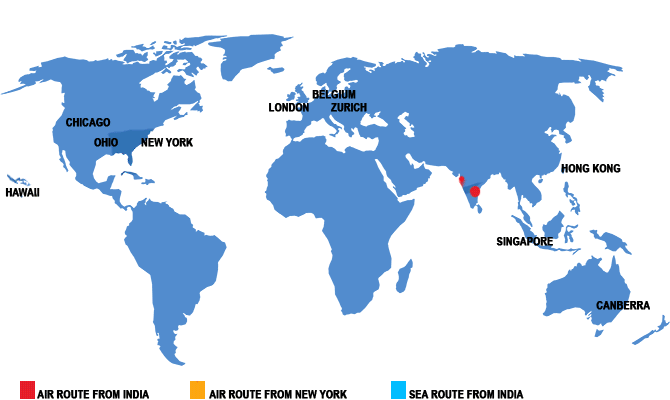
Your role in the recovery of hundreds of Indian idols and antiquities that are now slowly making their way back to India, as part of Operation Hidden Idol and other operations mounted by the ICE, makes you a big figure in India.
How did you get into this profession? And into recovering antiquities?
When I was growing up, there was a movie character named Indiana Jones. He kind of inspired me as a child to want to do something along the lines of hunting and rescuing treasure. And giving things back to villages.
There is even a movie called (Indiana Jones And The) Temple Of Doom where Indiana Jones recovers artefacts for a village in India! That was definitely an inspiration.
I joined (the) government (service) because I had learned there was a group in New York that did some cultural property investigations. It took me a little while to get into this group.
But when I got there, about 10 years ago, I really loved the work and loved the people I was working with. And I have been successful at working on this stuff.
What do you love most about the work?
The opportunity to do something good while stopping something bad.
I get to catch the bad guys and save a bit of history at the same time. That's very satisfying.
What is the high point of your daily work?
There are numerous high points in this field. It is gratifying when you recover an artefact. Doing so stopped it from going to the people who are trying to profit off another peoples's history and culture.
It is very, very satisfying, gratifying to give those pieces back later on in the investigation, when the pieces have been forfeited and (can be) repatriated.
It is also incredible if you can put handcuffs on a person who has been making a profit off of someone else's property.
There are a lot of different high points in an investigation -- high points that occur for me, hopefully, on a fairly regular basis.
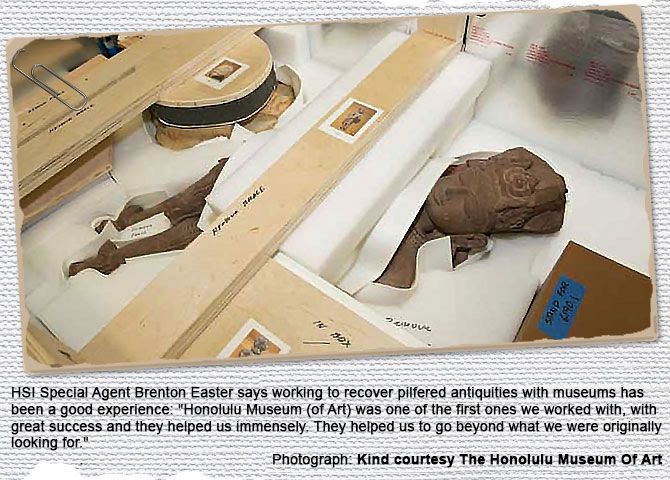
Probably no raid to uncover antiquities is similar to another? Without divulging anything confidential, can you please tell us if is there is some way in which you plan a raid? And how it happens? How it evolves?
I don't really term anything I do as a raid -- what we do is conduct operations.
Operations are typically long-term, multi-person investigations that we conduct in an effort to try and disrupt or dismantle transnational criminal organisations that are dealing in cultural property and profiting from it.
One of the goals is to see if we can link these individuals to other crimes as well, whether it is money laundering or other types of smuggling.
Cultural property crimes have been linked by the United Nations and others to terrorism. These links show the perpetrators to be associated with major criminal and terrorist networks like ISIS.
This is an issue that concerns not just our shared history, but also our current levels of international security.
Inside those operations, hopefully, we will have arrests; hopefully, we will have search warrants conducted. I think search warrants might be what you are thinking of when you hear raids.
Yes, and when you find something? Either in a shipment? Or in someone's house? Warehouse?
Right, right. In some of those search warrants we have executed, we have recovered hundreds of artefacts.
We have conducted search warrants in different kinds of locations. Some of the (places) we have seen are labs where people were getting huge amounts of antique coins or numismatic material or other types of metal-detected antiquities -- they have to recondition them in order to be able to sell them.
(They have) all kinds of apparatuses, magnifying glasses and pots of chemicals in order to try to bring those things up to marketable conditions.
We have done (laughs) search warrants in very uncomfortable situations -- in little storage units where temperatures, literally, might be 100 plus degrees. Or you might end up inside someone's garage.
And you will find some of the weirdest things inside of these garages. Like ancient Egyptian sarcophagi.
(These raids then) run the ambit from smaller antiquities to large. From cold to hot temperature conditions. From first-class storage units or high-end apartments to some of the most despicable, (rundown) conditions you can imagine.
It is the same with shipments. Sometimes, you will see something packaged exceptionally well. At other times, a shipment is packaged incredibly poor(ly).
You will see, unfortunately, the antiquity or cultural property suffer in some of those poor conditions. You feel the lack of regard for the history and culture, which is sad.
Is the Subhash Kapoor case a watershed when it comes to stolen Asian antiquities?
Has a lot changed after Kapoor was caught in terms of bringing about awareness and cleaning up things in general, on all sides?
There are pros and cons when a case like Operation Hidden Idol goes public.
It is great to heighten awareness within the art trade that stolen cultural property is out there. It is also important for the public to realise that this is a serious issue.
Unfortunately, there is still much work to be done when combating transnational criminal networks dealing in illicit cultural property.
When cases are made public, these sophisticated networks adapt their methods and change with the times in an effort to elude the authorities. (That) can be seen with the recent theft of a Jain idol of Lord Mahavira from Bihar (earlier this year).
People are still committing thefts and individuals are still smuggling and buying illicit cultural property.
It is a trade as old as civilisation and it won't end any time soon. The demand may have diminished, but it hasn't disappeared.
You said you first encountered a stolen Indian artefact nearly a decade ago. Would you say that you are pretty much an authority on identifying an Indian piece, its date or period?
One of the things we have been able to do here in New York is that the agency has become exceptionally (adept) at utilising sources.
We have been doing this for about 10 years (now). That allows me and my group the opportunity to obtain sources and to network and find resources within almost every single aspect of the trade.
If we need an expert for Syrian artefacts, we have got one.
If we need a person we can count on for Indian artefacts, we actually have quite a few (experts) at this point.
If we need somebody who will help us (with a) recast or with a restoration or if we need to see if something is a certain age or (for a) chemical analysis -- we have got experts that can do almost every single aspect of the trade.
A lot of the agents, like myself, have become very good at what we do (but) we still rely on those experts.
We know that, while we have to look at everything, they look at only one specific type of (historical) material. That way, if we ever do go to court, their opinions will be much harder to refute than any of ours.
So basically you have a good gut feeling about artefacts which you back up with connections with all kinds of experts. Would that be how to sum it up?
Yes. But it is not just the experts that we utilise. It is our contacts, our sources that we have developed over the past 10 years. That's one of the reasons why we have been so successful.
In fact, we changed the model, I think, over the last decade, of how these investigations are being conducted. We have gone from the seize and repatriate model, which is what we used to do.
We used to find artefacts predominantly, recover them, forfeit them and repatriate them.
Now, we are actually going after the individuals who are responsible, both here and abroad, for stealing another nation's cultural property, for stealing what might be considered a peoples's identity and heritage and giving it back.
So we have created experts, yes. But (also) sources.
People who will help us from inside the shipping community.
People who will help us from inside the dealer community. The restorer community.
People who really are aspects (participants in) the trade. Not just academics at a university. Or professors of different types of (historical) material and culture. Really people from all ranges of the trade.
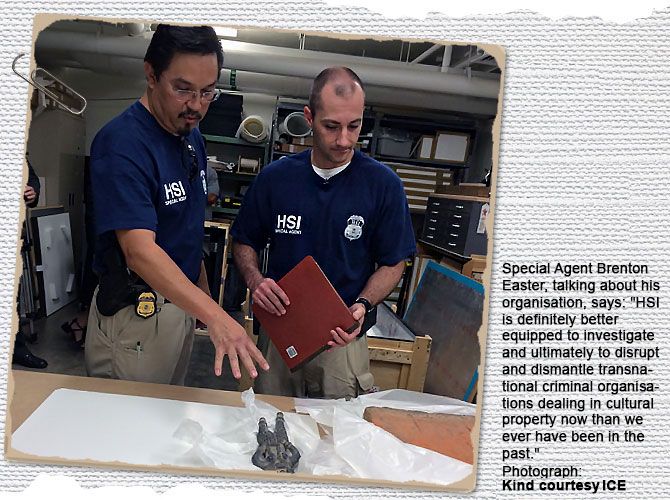
It is very hard to talk about figures. But do you have any measure of knowing how many Indian antiquities are still out there in America, which are recently stolen but not discovered yet? (Interpol, two years ago, estimated the illegal trade was worth $9 billion.)
That's a great question. I don't think anybody can give you a solid number. Or figure. One of the reasons for that is that I don't think there is anyone in India who can tell you how much was there. And how much has gone missing.
I can tell you that, over the last 10 years, our agency, working with CBP (US Customs and Border Protection) has identified numerous instances where Indian antiquities have been either smuggled into the United States or appeared to have been stolen and imported into the United States.
I think we recovered some Indian antiquities just this last March and the people still dealing in this illicit material should be ashamed. Especially after seeing how Operation Hidden Idol has exposed how ripe the market is with problems.
So, although people are becoming aware that this is a problem, (there is still a) market for Indian antiquities.
The market is starting to become aware that there are some problems with this portion of the trade; that there might be some issues. I think they are reacting to that.
Hopefully, the trade of illicit antiquities out of India will decrease. Awareness was (boosted) with some of our successes.
It is also going to have an impact, not just on the trade here in the United States and abroad, but on how things progress in India.
I have been reading about additional arrests down in Tamil Nadu. That's wonderful. I am glad that we have been able to help and to provide whatever assistance and evidence we can.
I think the collaboration that is occurring between investigators and prosecutors, and between countries, with regard to these investigations is very, very important. Hopefully, it will continue to grow.
(Easter told National Geographic in June: 'I don't always know the good guys around the world, the other law enforcers in different countries. But the bad guys all seem to know each other. It's like they're on speed dial.'
He was recently informed by a collaborator that smugglers/dealers have gotten to know about ICE's successes to which the special agent said grimly to National Geographic: 'Guess that means I've got their attention. Good. Now I know I'm doing my job.')
We are in 2016. Let's look at it over a 10 year time frame. What are the chances that the journey of a stolen Indian antiquity travelling secretly from a historic site in India to America will remain unbroken today? And how does today compare with how it was 10 years ago or five years ago?
I think the big difference between five or 10 years ago and now is the level of awareness. People are much more cognisant that there is an issue. Cognisant that there is illicit trade. Because of that, the market is adapting and changing.
I also (believe) that custom officers, both here and abroad, are probably trying to look for more of these problematic shipments. That's one way in which things have changed.
So is it 50 per cent better? Or 90 per cent better than say five or 10 years ago?
I think it is impossible to give a number on that right now. Because we don't know what numbers were in the past.
But I think the odds have dramatically decreased especially since the levels of awareness have increased.
Museums across America -- and across the world, Australia, Europe -- now understand the issue of pilfered artefacts. They are trying very hard to make sure they are not acquiring new stolen antiquities. But isn't it still happening in a small way? Accidentally? Or through carelessness?
What I have seen, for the most part, from the museum community in the United States and abroad, (is that) when there is a problem they work with law enforcement to try and remedy it.
When I deal with them, they are extremely agreeable and complicit. They help me out.
The Honolulu Museum (of Art) was one of the first ones we worked with, with great success. They helped us immensely. They helped us to go beyond what we were originally looking for.
I think that museums are currently trying to do the right thing. You are always going to have people who are trying to pull a fast one.
Crime exists, right? That's why I am here. But for the most part, I think people are genuinely trying to do the right thing.
I think that's what you see across the board with these institutions. So I don't think it is fair to say that an institution, whether it is an auction house or a museum as a whole is doing something wrong.
If they do do something wrong, then it is probably one individual responsible for that, not an institution as a whole.
Could there exceptions to the rule? Well, of course. That's what I am here, to try and find out.
I applaud museums actually at this point for their assistance. I find a lot of private collectors have also been very helpful in terms of the investigations.
Have attitudes changed considerably in America and the world over with reference to how Asian antiquities are acquired?
The climate surrounding the acquisition of art in the world has steadily changed since the UNESCO agreement in 1970. Most museums now hold themselves to a high standard when they look to purchase cultural property.
In most cases, it appears that collectors and institutions are doing their due diligence; however, there will always be the few exceptions to the rule.
We just saw ancient treasure lost to history due to ISIS terrorism in Palmyra, Syria. It leads to views that it is first-world museums that keep treasures of other cultures safe.
Many are of the view: 'Well, we are keeping it more safe than them.' And better a stolen artefact in a museum than it being lost entirely to history.
In India too, so many of our ancient treasures are not looked after well enough. Is that an attitude you are up against?
There are some people who do have that attitude. People that feel some things of history will be safer in institutions.
And their homes?
And in their homes.
But you know what? I am not paid to have that opinion. I am paid to find violations of law. So I don't concern myself with those arguments.
What I concern myself with is if someone is knowingly transporting or moving stolen property or if any import regulations or laws are being broken.
If somebody is going to let their thinking cloud their judgement and do something wrong, then I will enforce the law.
If their opinions are not affecting whether or not they are breaking the law, then they are fully entitled to them.
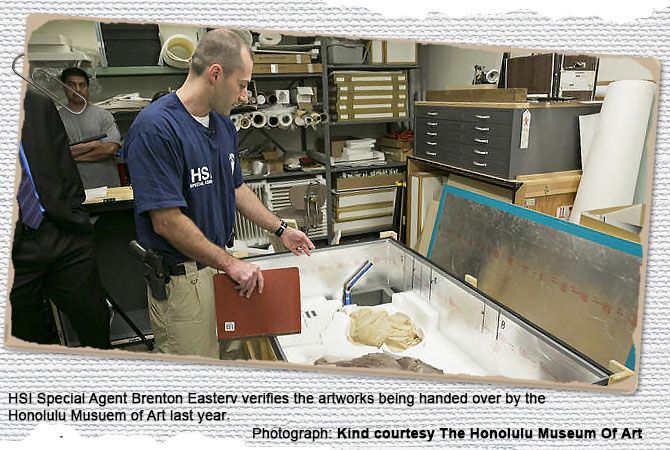
You mentioned that a lot of work needs to be done to keep antiquities from getting stolen and leaving the country of their origin. In the case of India, what are two key points? Especially anything that needs to be done from the Indian side?
One of the things that made this case (Hidden Idol) very successful was the inventory that was held by the French Institute of Pondicherry (Institut Français de Pondichéry, the 1955-established institution that studies Indian civilisation and culture and has a 160,000 photo archive devoted to ancient South Indian art).
Those inventories of what were in (Tamil Nadu) temples allowed us to (prove) that certain artefacts had been were stolen from those temples.
What that shows you is that inventories are incredibly useful and helpful to making criminal cases.
(In) Other cases (relating) to Indian antiquities, theft reports and records showing that something had (belonged to someone) had been useful. Or documentation of a person's property or temple property. Basically, paper trails.
Is the ICE now well-outfitted to deal with intercepting smuggled Asian, specifically Indian, artefacts? What are some of the system changes that have come about? Is there enough manpower?
HSI (Homeland Security Investigations) is definitely better equipped to investigate and ultimately to disrupt and dismantle transnational criminal organisations dealing in cultural property now than we ever have been in the past.
We annually train agents all over the country to investigate these crimes and there are now two or more agents at most offices and ports around the nation prepared and searching for illicit cultural property.
We have continued to increase our numbers of seizures and arrests on a regular basis and it is anticipated that we will continue to successfully combat cultural property crime.
IMAGING: Rajesh Karkera/Rediff.com









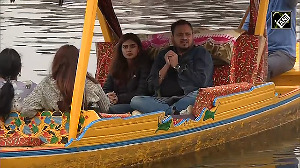

 © 2025
© 2025